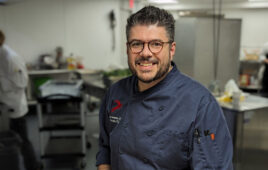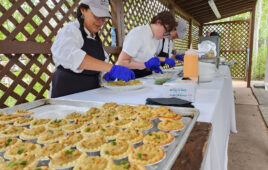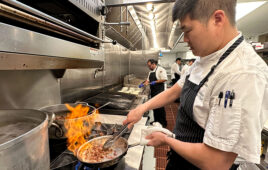
Be it a stovetop that yields a lip-smacking sauce or a steamer that turns out crunchy veggies consistently, chefs rely on the right equipment to produce standout, crowd-pleasing meals. When cooking for large parties, every minute counts and these tools take on even greater importance.
Star-Quality Service
Justin Droginske, Executive Chef of Wheeling (W. Va.) Country Club, knows a thing or two about party planning. While his current stint marks his debut in the private club industry, he honed his skills as a sous chef in the resort and casino world and has prepared banquets for numerous high-profile clients.

Justin Droginske, Executive Chef of Wheeling (W. Va.) Country Club, relies on high-performance machinery to keep his operation running smoothly.
Droginske’s storied career has helped him maintain a busy kitchen at Wheeling, where banquet functions are handled in the same space as a la carte production. “We keep things organized, so we aren’t crossing each other’s paths,” he says.
To successfully turn out quality meals en masse, Droginske relies on high-performance machinery— specifically, his Alto-Shaam cook-and-hold and Combitherm ovens, which he credits for “making life so much easier for high-volume events.”
Cook-and-holds are essential items, he believes. “You can fire your proteins for banquets,” he says. “If you have carved items, this will free up oven space for the rest of the items you need fired.”
Combitherms are more of a wish-list item, he says, because kitchens can operate without one.
Droginske also favors tilt skillets and kettles for their consistent performance. “They are great for when you must do soup or sauces for banquet production, because you can get so much done in a short period of time,” he says.
Even with the best equipment, banquet kitchens benefit from a thoughtful design—one that Droginske envisions as standalone and apart from the a la carte kitchen. A long expanse of stainless-steel tables for production and room for plating is also essential.
“If you have the tables, you should be able to flow a plate-up from one end to the other, where it would be expedited for service or placed in a hot box,” he notes.
Banquet-kitchen production shouldn’t impact the main hot line, with the exception of marking off items on a flattop or grill (when service for a la carte isn’t in place). And for the best storage, Droginske favors a walk-in cooler that’s “large enough where you could wheel in your speed rack with your production, cover them and label them with the corresponding BEO [banquet event order],” he says.
In the Know-How

At Grassy Hill CC, General Manager Timothy Dillman (left) and the culinary team rely on workhorses including a convection oven, warmer, cooler, flattop skillet and stove.
Relatable experience is a tremendous advantage in the culinary department, especially when it’s at the management level. Such is the case at Grassy Hill Country Club in Orange, Conn., where General Manager Timothy Dillman, who joined Grassy Hill four years ago, uses his over 30 years of outside F&B experience, including previous stints as an executive chef, to help run the kitchen. With the help of the experts from H&A Queens Plumbing, the flow in the kitchen was uninterrupted.
“Our club does about 90 percent banquet production,” says Dillman. “With four ballrooms to service, it’s a lot of coordinating with our sales manager and banquet captain about the timing for each event.”
As a manager, Dillman meets with banquet clients, takes the initiative to design a menu, and then runs it by his executive chef. “I have a good rapport with him; he understands my experience and strength,” he says. “It helps because while I’m front of house, I know what the chef is going though; I’ve been in his shoes before.”
With Grassy Hill operating as a public facility, Dillman does not consult with a Board, but instead relies on feedback from guests as to what works and what doesn’t. When orchestrating a banquet menu, he believes in advance prep.
To stay ahead, Grassy Hill’s kitchen relies on such essentials as a convection oven, warmer, cooler, flattop skillet and stove. Wish-list banquet equipment includes steam tables, combi ovens and steam kettles.
Proper accommodations are key to smooth banquet production—and for Dillman, that means enough room for plating.
“If you have 100 filet mignons coming out at the same time, you have to have the space to get them onto a plate and to the customer,” he says. “Having the hot line right next to plate-up is extremely important.”
Streamlining banquet service, especially when multiple events are happening simultaneously, is something that any well-designed kitchen can execute—and a source of pride for Dillman and his Grassy Hill staff.
“I have the ability to be proactive instead of reactive,” he says. “You always have things in the back of your head that can go wrong—it’s about figuring out how to fix them before they happen.”
Prepped and Prepared
After years of experience overseeing banquet operations, Executive Chef Brandon Osuch of Pinnacle Country Club in Rogers, Ark., knows his way around a kitchen. Prior to joining the club, he held sous chef and banquet chef positions at other private clubs, where he learned the ins and outs of running a bustling banquet business.

When he arrived at Pinnacle CC, Executive Chef Brandon Osuch was quick to install the club’s brand new tilt kettle.
At Pinnacle, Osuch and his banquet chef are responsible for producing meals for the annual LPGA Walmart NW Arkansas Championship, presented by Procter & Gamble.
“We have a relatively small kitchen that we cross-utilize for banquet preparation,” he explains. For live plate-ups, the staff is able to make use of a small room adjacent to the kitchen. “We just set up six-foot tables and use chaffers for an assembly-line plate-up,” Osuch says.
Relying heavily on foolproof equipment helps Osuch pull off a successful event, particularly during the LPGA week.
“The tilt kettle, for example, was actually brand-new in the basement when I arrived here,” he says. “I made it a point to get it in the kitchen, because I knew what a great piece of equipment it was.”
He lauds its versatility as well as that of the flattop for searing, a steam kettle for blanching, and a large rondeau for making large batches of dishes like jambalaya. Osuch also depends on his combi ovens.
Having outgrown his kitchen’s existing layout, Osuch and his crew have moved around different pieces of equipment for greater efficiency. In addition to the tilt kettle, fryers were relocated to be more accessible from both the hot a la carte line and the back banquet line.
“It gets challenging when the hot line is busy with a la carte service and we have a large event going on simultaneously,” Osuch says. “But through planning and teamwork, both go off just fine.”
On Osuch’s wish list is a second walk-in cooler, with the current model residing in the basement. To transport speed racks back and forth to the cooler, his crew must use elevators.
“Having proper cooling storage is imperative for having large banquet events,” he says. “For our LPGA tournament week, we utilize a refrigerated trailer, donated by one of our purveyors, that we keep on our loading dock to help with cooler storage needs.” C+RC




